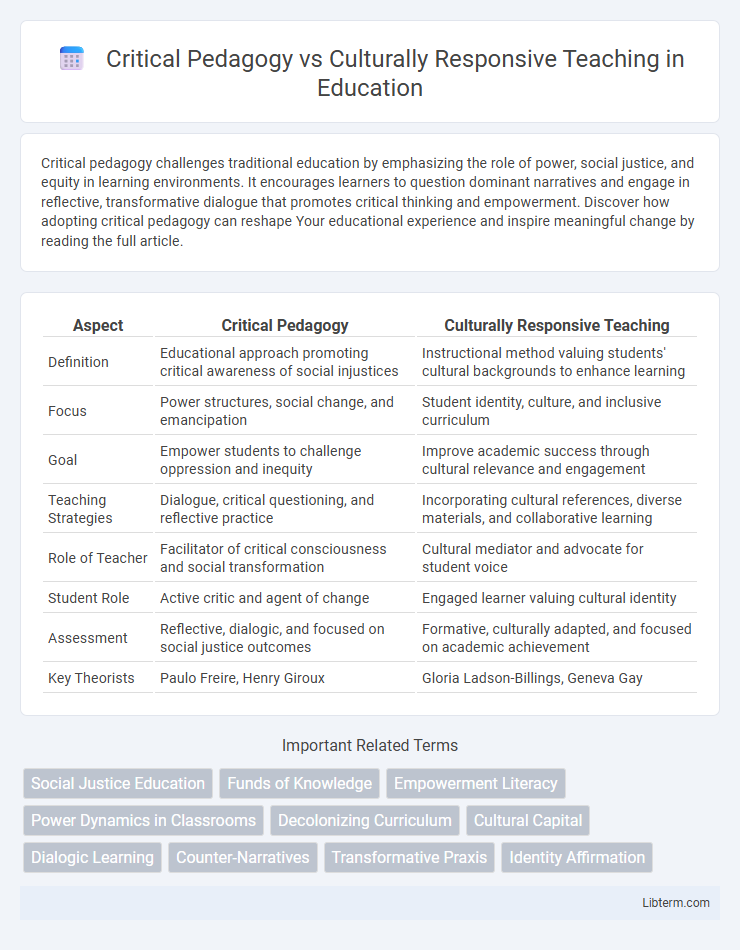Critical pedagogy challenges traditional education by emphasizing the role of power, social justice, and equity in learning environments. It encourages learners to question dominant narratives and engage in reflective, transformative dialogue that promotes critical thinking and empowerment. Discover how adopting critical pedagogy can reshape Your educational experience and inspire meaningful change by reading the full article.
Table of Comparison
| Aspect | Critical Pedagogy | Culturally Responsive Teaching |
|---|---|---|
| Definition | Educational approach promoting critical awareness of social injustices | Instructional method valuing students' cultural backgrounds to enhance learning |
| Focus | Power structures, social change, and emancipation | Student identity, culture, and inclusive curriculum |
| Goal | Empower students to challenge oppression and inequity | Improve academic success through cultural relevance and engagement |
| Teaching Strategies | Dialogue, critical questioning, and reflective practice | Incorporating cultural references, diverse materials, and collaborative learning |
| Role of Teacher | Facilitator of critical consciousness and social transformation | Cultural mediator and advocate for student voice |
| Student Role | Active critic and agent of change | Engaged learner valuing cultural identity |
| Assessment | Reflective, dialogic, and focused on social justice outcomes | Formative, culturally adapted, and focused on academic achievement |
| Key Theorists | Paulo Freire, Henry Giroux | Gloria Ladson-Billings, Geneva Gay |
Introduction: Understanding Critical Pedagogy and Culturally Responsive Teaching
Critical Pedagogy emphasizes empowering students to challenge and transform societal inequalities through education, rooted in the works of Paulo Freire. Culturally Responsive Teaching focuses on recognizing and integrating students' cultural backgrounds into the curriculum to enhance learning and engagement. Both approaches aim to create inclusive educational environments but differ in their primary strategies and theoretical foundations.
Historical Foundations of Critical Pedagogy
Critical Pedagogy traces its historical foundations to early 20th-century Marxist theory and Paulo Freire's seminal work, "Pedagogy of the Oppressed," which emphasized education as a tool for social justice and liberation. It critiques traditional power dynamics within educational systems, advocating for critical consciousness and empowering marginalized voices. Unlike Culturally Responsive Teaching, which centers on validating students' cultural identities, Critical Pedagogy fundamentally challenges hegemonic structures and promotes systemic change through critical reflection and collective action.
Origins and Evolution of Culturally Responsive Teaching
Culturally responsive teaching originated in the late 20th century, influenced by scholars like Gloria Ladson-Billings, who emphasized the importance of connecting curriculum to students' cultural backgrounds. This approach evolved from critiques of traditional pedagogy's inability to address diverse learners' needs and aims to empower students by validating their cultural identities within the learning environment. Unlike critical pedagogy, which centers on power structures and social justice broadly, culturally responsive teaching specifically targets academic success through culturally relevant pedagogical practices.
Core Principles of Critical Pedagogy
Critical Pedagogy centers on empowering students to challenge and transform oppressive social structures by fostering critical consciousness and promoting dialogue-based learning. Its core principles include recognizing power dynamics, encouraging reflexivity, and emphasizing social justice to develop learners as active agents of change. This pedagogical approach contrasts with Culturally Responsive Teaching, which primarily adapts instruction to students' cultural contexts to enhance engagement and achievement.
Key Elements of Culturally Responsive Teaching
Culturally Responsive Teaching centers on validating and affirming diverse cultural backgrounds through curriculum content, instructional strategies, and classroom environment. Key elements include recognizing students' cultural references, fostering an inclusive curriculum reflecting multiple perspectives, and employing teaching methods that build on students' prior knowledge and experiences. Unlike Critical Pedagogy, which emphasizes power structures and social justice activism, Culturally Responsive Teaching primarily aims to enhance academic success by promoting cultural competence and student engagement.
Approaches to Curriculum Design
Critical Pedagogy emphasizes curriculum design that challenges power structures and promotes social justice by integrating students' lived experiences and encouraging critical reflection on societal inequalities. Culturally Responsive Teaching focuses on incorporating students' cultural backgrounds and knowledge systems into the curriculum to enhance engagement and academic achievement by validating diverse identities. Both approaches prioritize student-centered learning but differ in their emphasis on social critique versus cultural affirmation.
Classroom Dynamics: Power, Identity, and Voice
Critical Pedagogy challenges traditional classroom hierarchies by emphasizing teacher-student collaboration to redistribute power and amplify marginalized voices, fostering critical consciousness about social inequalities. Culturally Responsive Teaching prioritizes affirming students' cultural identities through curriculum content and teaching methods, creating an inclusive learning environment that validates diverse experiences and perspectives. Both approaches transform classroom dynamics by valuing student voice and identity while addressing power imbalances to promote equitable learning outcomes.
Teacher Roles and Student Agency
Critical Pedagogy positions teachers as facilitators who challenge power structures and encourage students to question societal norms, fostering transformative learning experiences. Culturally Responsive Teaching requires educators to create inclusive environments that respect and integrate students' cultural backgrounds, promoting engagement and identity affirmation. Both approaches emphasize student agency by encouraging critical thinking and empowering learners to actively participate in their education and community.
Strengths and Limitations: Comparative Analysis
Critical Pedagogy empowers students to challenge and transform systemic inequalities, fostering critical consciousness and social justice, but it may face resistance in standardized educational settings and requires a high level of teacher expertise. Culturally Responsive Teaching enhances student engagement and academic success by validating diverse cultural backgrounds and promoting inclusive curricula, though its effectiveness depends on authentic implementation and ongoing cultural competence development. Both approaches prioritize equity, yet Critical Pedagogy centers on radical systemic change while Culturally Responsive Teaching emphasizes adaptation within existing structures.
Integrating Critical Pedagogy and Culturally Responsive Teaching for Transformative Education
Integrating Critical Pedagogy and Culturally Responsive Teaching creates a transformative education framework that empowers students to challenge systemic inequalities while embracing their cultural identities. This approach fosters critical consciousness and inclusivity by combining Paulo Freire's emphasis on dialogue and reflection with Geneva Gay's focus on cultural relevance and validation in curriculum. Educators implementing this integration promote equity and social justice, enabling learners to become active agents of change within their communities.
Critical Pedagogy Infographic

 libterm.com
libterm.com